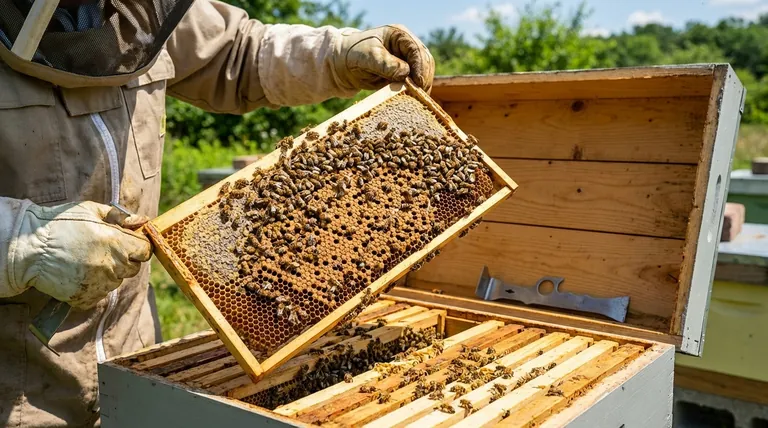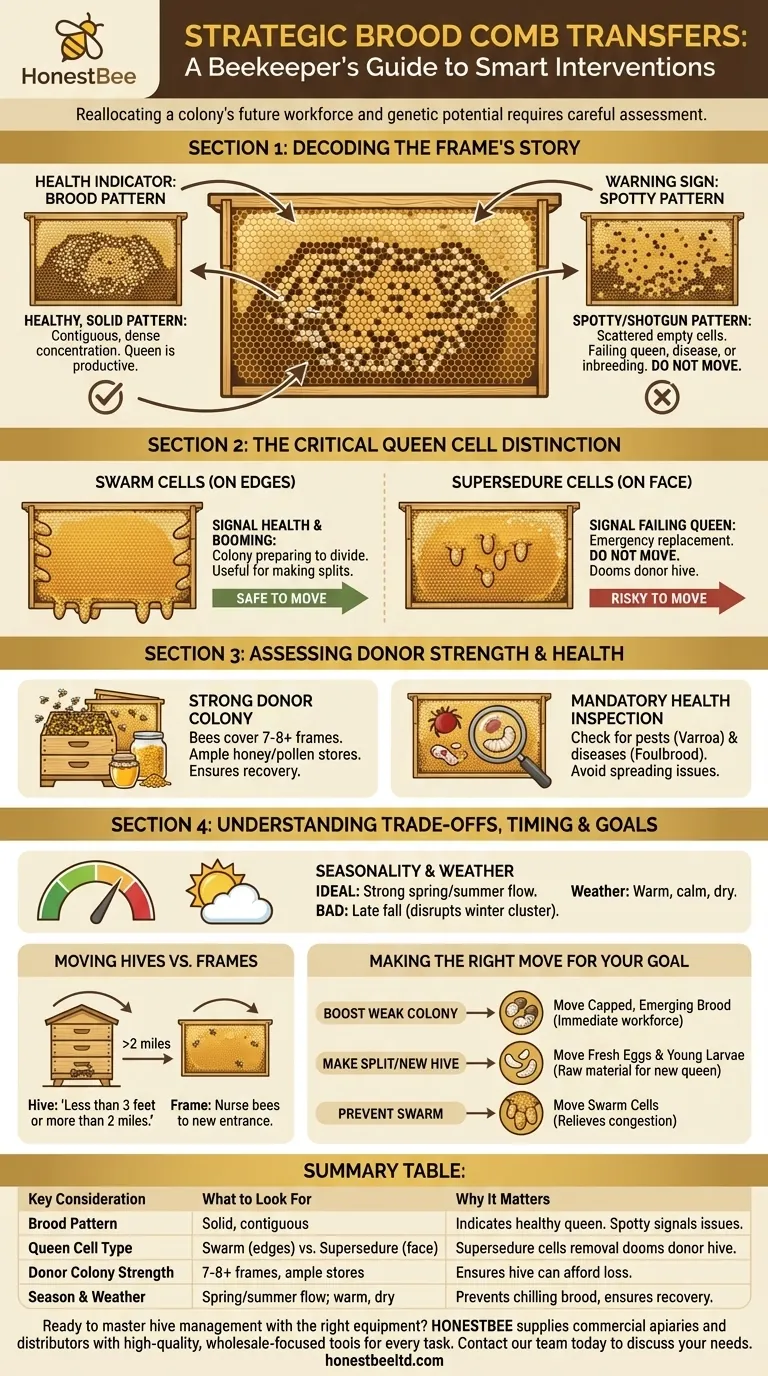Before transferring a brood comb, a beekeeper must critically evaluate three things: the type of queen cells present, the health and population of the donor colony, and the external conditions like season and weather. This assessment ensures the move strengthens the receiving hive without fatally weakening the one it came from.
Moving a frame of brood is not a simple transfer of bees; it is a strategic intervention that reallocates a colony's future workforce and genetic potential. The success of this action depends entirely on understanding the story the frame tells and the context of the hives involved.

Decoding the Story on the Frame
Every frame of brood provides a detailed report on the colony's current state and future intentions. You must learn to read it correctly before taking action.
Brood Pattern as a Health Indicator
A healthy, productive queen lays eggs in a solid, contiguous pattern. Look for a dense concentration of cells where brood of a similar age—eggs, larvae, or capped pupae—are grouped together.
A spotty or "shotgun" pattern, with many empty cells scattered among capped brood, is a clear warning sign. This often indicates a failing queen, inbreeding, or disease, and this is not a frame you should move.
The Critical Queen Cell Distinction
Finding queen cells is a pivotal moment that dictates your next move. Their location on the frame is the key differentiator.
Swarm cells are typically found along the bottom and side edges of the frame. They signal a healthy, booming colony that is preparing to divide.
Supersedure cells are usually located on the face of the comb, in the middle of the brood area. These cells indicate the bees have decided their queen is failing and are raising an emergency replacement.
The Dangers of Moving the Wrong Cell
Transferring a frame with swarm cells can be a useful way to make a split and harness the colony's reproductive energy.
However, moving a frame with supersedure cells is extremely risky. By removing the colony's only solution to a failing queen, you could doom the original hive, leaving it hopelessly queenless.
Assessing the Donor Colony's Strength
Never take resources from a colony that cannot afford to share them. A strong donor hive is a prerequisite for any successful brood transfer.
Is the Colony Strong Enough to Share?
A suitable donor hive should be packed with bees, covering at least seven or eight frames in a standard ten-frame box. It must have ample stores of honey and pollen to support its own population after the frame is removed.
Taking brood from a moderately-sized or weak colony can set it back significantly, jeopardizing its ability to grow and survive.
A Mandatory Health Inspection
Before moving any frame, perform a thorough inspection for pests and diseases. Pay close attention to signs of a high Varroa mite load or, more seriously, diseases like American or European Foulbrood.
Transferring a single frame can transfer the entire problem, potentially infecting a healthy hive and creating a much larger issue in your apiary.
Understanding the Trade-offs and Timing
The success of your intervention is heavily influenced by factors outside the hive. Acting at the wrong time can do more harm than good.
The Impact of Seasonality
The ideal time to transfer brood is during a strong spring or early summer nectar flow. The donor colony can easily replace the lost bees and resources, and the receiving colony has the resources to care for the new brood.
Transferring brood in late fall is generally a mistake. It disrupts the winter bee cluster and weakens a colony right before it faces its most stressful season.
Weather as a Critical Factor
Only perform hive manipulations on warm, calm, and dry days. Opening the hive in cold, windy, or rainy weather can chill the exposed brood, killing the larvae and pupae you intend to move.
Moving Hives vs. Moving Frames
A common beekeeping mantra is to move a hive "less than 3 feet or more than 2 miles." This prevents foraging bees from returning to the original location and getting lost.
Crucially, this rule applies to moving an entire hive, not a single frame. When you move just one frame of brood, the nurse bees on it will stay and reorient to their new hive entrance.
Making the Right Move for Your Goal
Your reason for moving brood determines which frame is the right choice. Always act with a clear purpose.
- If your primary focus is boosting a weak colony: Transfer a frame of capped, emerging brood from your strongest hive. This provides an immediate infusion of young adult bees.
- If your primary focus is making a split or new hive: Transfer a frame containing fresh eggs and young larvae, ideally with a swarm cell if available. This gives the new colony the raw material to raise its own queen.
- If your primary focus is preventing a swarm: Remove frames with swarm cells to create a new split. This relieves congestion and satisfies the colony's impulse to reproduce without losing your bees.
Ultimately, a thoughtful and well-timed brood transfer is one of the most powerful tools for managing healthy and productive beehives.
Summary Table:
| Key Consideration | What to Look For | Why It Matters |
|---|---|---|
| Brood Pattern | Solid, contiguous pattern of similar-aged brood. | Indicates a healthy, productive queen. A spotty pattern signals disease or a failing queen. |
| Queen Cell Type | Swarm Cells (on edges) vs. Supersedure Cells (on comb face). | Moving supersedure cells can doom the donor hive by removing its queen replacement. |
| Donor Colony Strength | Bees covering 7-8+ frames, ample honey/pollen stores. | Ensures the donor hive can afford to lose resources without being weakened. |
| Season & Weather | Strong spring/summer nectar flow; warm, calm, dry days. | Prevents chilling brood and ensures colonies can easily recover from the manipulation. |
Ready to master hive management with the right equipment?
Strategic brood transfers are just one part of successful apiary management. Having durable, reliable beekeeping supplies is essential for performing these interventions safely and effectively.
HONESTBEE supplies commercial apiaries and beekeeping equipment distributors with high-quality, wholesale-focused equipment. We help you build stronger, more productive operations with the tools you need for every task, from routine inspections to complex splits.
Contact our team today to discuss your wholesale supply needs and discover how our equipment can support your hive's health and productivity.
Visual Guide

Related Products
- HONESTBEE Advanced Ergonomic Stainless Steel Hive Tool for Beekeeping
- HONESTBEE Professional Bee Frame Machine for Side Bar Shaping
- Boardman Entrance Bee Feeder Durable Galvanized Steel and Wood Construction for Beekeeping
- Electric Honey Press Machine for Squeezing Honey Comb Press Equipment
- Plastic Chinese Queen Grafting Tool for Bee Queen Rearing
People Also Ask
- What are the basic tools for beekeeping? Essential Starter Kit for Safe & Successful Hive Management
- What tools are used for cleaning frames? A Beekeeper's Simple 4-Tool Guide
- What are the features of a regular hive tool? The Essential Multi-Tool for Every Beekeeper
- What is the hole in a hive tool for? A Multi-Tool for Apiary Repairs and Maintenance
- How should beekeepers handle bees when using a hive tool? Master Calm, Deliberate Techniques



















